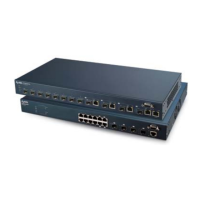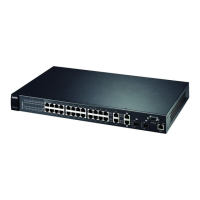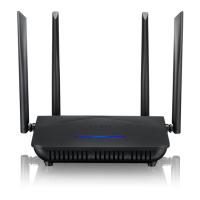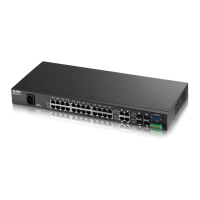Chapter 8 Broadband
AX/DX/EX/PX Series User’s Guide
156
IPv6 DNS Server (This is available only when you select IPv4 IPv6 DualStack or IPv6 Only in the IPv4/IPv6 Mode field.
Configure the IPv6 DNS server in the following section.)
Obtain IPv6 DNS
Info
Automatically
Select Obtain IPv6 DNS Info Automatically to have the Zyxel Device get the IPv6 DNS server
addresses from the ISP automatically.
Use Following
Static IPv6 DNS
Address
Select Use Following Static IPv6 DNS Address to have the Zyxel Device use the IPv6 DNS server
addresses you configure manually.
Primary DNS
Server
Enter the first IPv6 DNS server address assigned by the ISP.
Secondary DNS
Server
Enter the second IPv6 DNS server address assigned by the ISP.
IPv6 Routing Feature (This is available only when you select IPv4 IPv6 DualStack or IPv6 Only in the IPv4/IPv6 Mode
field. You can enable IPv6 routing features in the following section.)
MLD Proxy
Enable
Select this check box to have the Zyxel Device act as an MLD proxy on this connection. This
allows the Zyxel Device to get subscription information and maintain a joined member list for
each multicast group. It can reduce multicast traffic significantly.
Apply as Default
Gateway
Select this option to have the Zyxel Device use the WAN interface of this connection as the
system default gateway.
DS-Lite
This is available only when you select IPv6 Only in the IPv4/IPv6 Mode field. Enable Dual Stack
Lite to let local computers use IPv4 through an ISP’s IPv6 network. See Dual Stack Lite on page
149 for more information.
Click this switch to let local computers use IPv4 through an ISP’s IPv6 network. When the switch
goes to the right , the function is enabled. Otherwise, it is not.
DS-Lite Relay
Server IP
Specify the transition router’s IPv6 address.
ATM PVC Configuration (This is available only when you select ADSL over ATM in the Type field.)
VPI [0-255] The valid range for the VPI is 0 to 255. Enter the VPI assigned to you.
VCI [32-65535] The valid range for the VCI is 32 to 65535 (0 to 31 is reserved for local management of ATM
traffic). Enter the VCI assigned to you.
Encapsulation Select the method of multiplexing used by your ISP from the drop-down list box. Choices are:
• LLC/SNAP-BRIDGING: In LCC encapsulation, bridged PDUs are encapsulated by identifying
the type of the bridged media in the SNAP header. This is available only when you select IPoE
or PPPoE in the Select DSL Link Type field.
• VC/MUX: In VC multiplexing, each protocol is carried on a single ATM virtual circuit (VC). To
transport multiple protocols, the Zyxel Device needs separate VCs. There is a binding
between a VC and the type of the network protocol carried on the VC. This reduces
payload overhead since there is no need to carry protocol information in each Protocol
Data Unit (PDU) payload.
Service
Category
Select UBR Without PCR for applications that are non-time sensitive, such as email.
Select CBR (Continuous Bit Rate) to specify fixed (always-on) bandwidth for voice or data traffic.
Select Non Realtime VBR (non real-time Variable Bit Rate) for connections that do not require
closely controlled delay and delay variation.
Select Realtime VBR (real-time Variable Bit Rate) for applications with bursty connections that
require closely controlled delay and delay variation.
Peak Cell Rate
[cells/s]
Divide the DSL line rate (bps) by 424 (the size of an ATM cell) to find the Peak Cell Rate (PCR). This
is the maximum rate at which the sender can send cells. Type the PCR here.
Sustainable Cell
Rate
The Sustain Cell Rate (SCR) sets the average cell rate (long-term) that can be transmitted. Type
the SCR, which must be less than the PCR. Note that system default is 0 cells/sec.
Table 34 Network Setting > Broadband > Add or Edit New WAN Interface (Routing Mode) (continued)
LABEL DESCRIPTION

